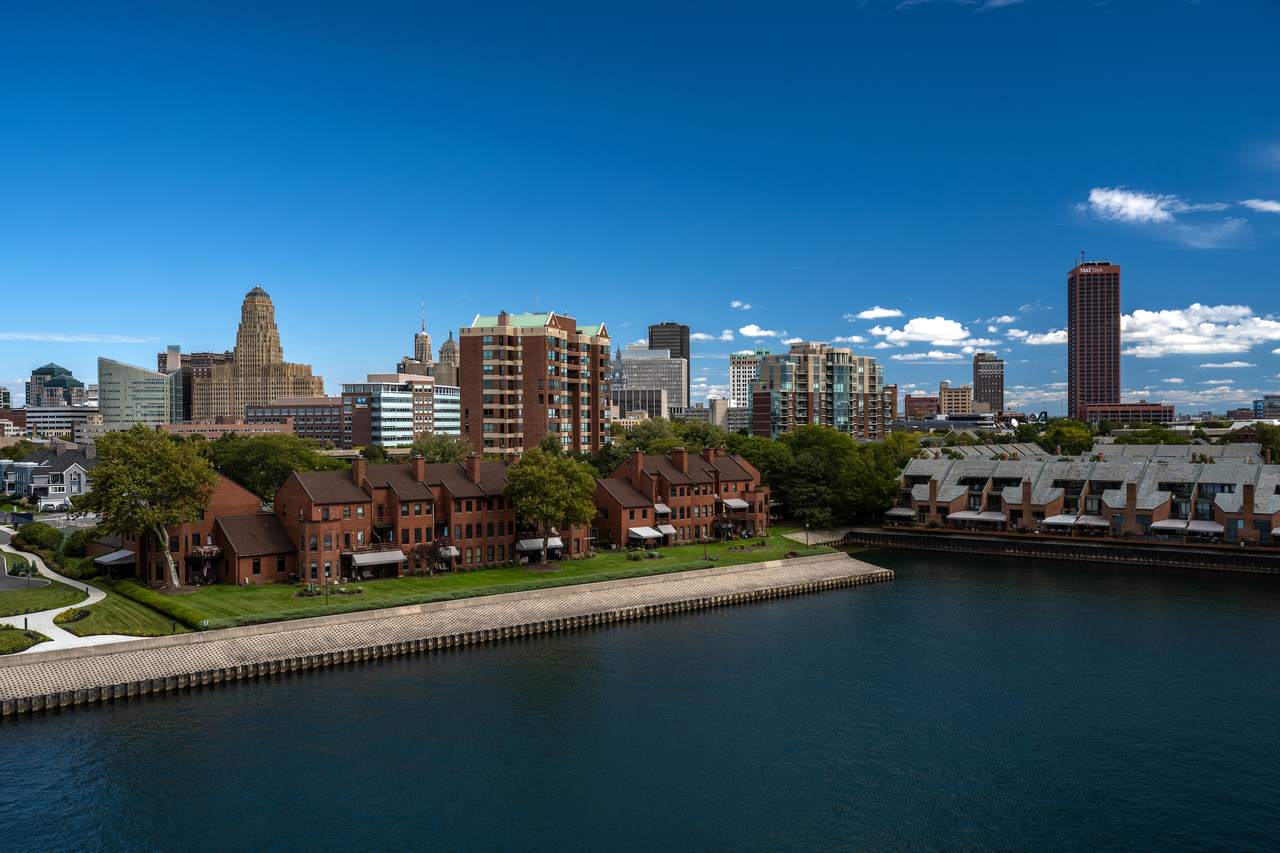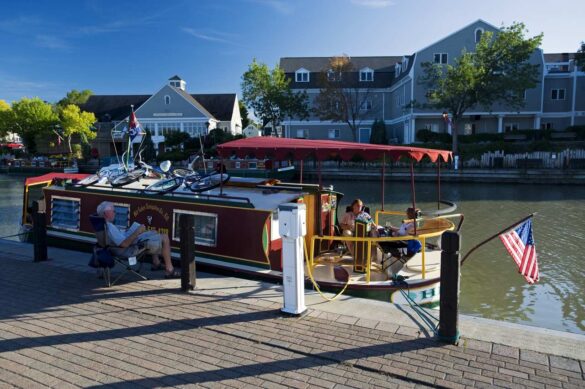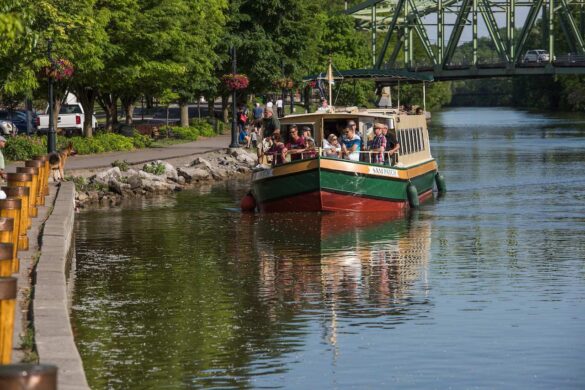The incredible Erie Canal is the longest artificial waterway in North America, putting New York on the map as the Empire State. It transformed the city into the nation’s principal seaport and opened the interior of North America.
In 2000, this 363-mile waterway was designated a national heritage corridor, a recreational waterway lined with cycling and hiking trails, thriving cities town and villages, decorated with boats and barges and awash with natural resources.
In 1825, the Erie Canal became the first navigable inland waterway to channel across New York State and connect the Atlantic Ocean to the Great Lakes. Construction began in 1817, and took eight years to complete. Originally four feet deep, 40 feet wide and 363 miles long, it was an engineering masterpiece of its time.
Fuelled with a shovel and a jug of whisky, local farmers and Irish immigrants were among Americans who were paid in food and accommodation. They toiled through swamps infested with mosquitoes, felled trees and woodlands by hand and animal power and overcame the rapids and waterfalls of the Mohawk River. They devised equipment to pull stumps, developed hydraulic cement that hardened underwater and used hand drills and black powder to blast stone to cross rocky cliffs. The Lockport Flight was one of the challenges solved with a staircase of five locks, lifting and lowering boats 49 feet, a feat which helped to shape canal tourism today. When built, it was the second-longest in the world after the Grand Canal in China.
The canal linked future cities such as Syracuse, Rochester and Buffalo. It brought wealth and trade along its path, planting the seeds for today’s thriving cities and transported people along with ideas that changed the world. And it brought character to the cities, too.
Syracuse, the county seat of Onondaga County, is home to the historical Erie Canal Museum housed in the Syracuse Weighlock Building. It was in Syracuse that the first Drive-Up Teller for passing canal boats was created. Low-level windows remain, although the canal has been rerouted.
Another old boy in town is the Marriot Syracuse Hotel restored to its 1920s heyday enjoyed by the Rolling Stones, Elvis and The Eagles and a party venue for Yoko and John Lennon.
Syracuse is the gateway to the Finger Lakes region, laced with wine trails, orchards, gorges and state parks and edged with glacier-formed hills harbouring deep valleys.
The charming village of Skaneateles is affectionately known as the Crown Jewel of this region, and from the shore of Skaneateles Lake, boat cruises pass million-dollar homes, including the home of the founder of Revlon Cosmetics, with landscaped gardens spilling onto the shoreline while fishermen search for rainbow trout. Visit Anyela’s Vineyard & Winery for wine tastings and Beak & Skiff in Lafayette for a flight of cider – the orange creamsicle was a firm favourite.
The cultural capital of Rochester has long been referred to as Kodak Town. The George Eastman Museum is the world’s oldest photographic museum, housed within the 1905 colonial revival mansion, while the Strong National Museum of Play proves that no one is too old to play amongst its vast collection of toys, which delves into the science of play.
![Sam Patch canal boat ride along Erie Canal in Pittsford, NY [ErieCanal_50]](https://www.thetravelmagazine.net/wp-content/uploads/Sam-Patch-canal-boat-ride-along-Erie-Canal-in-Pittsford-NY-ErieCanal_50.jpg)
Sam Patch canal boat ride along Erie Canal in Pittsford, NY
Nearby are the Sam Patch Erie Canal Tours, which run narrated trips onboard a replica of an 1880s packet boat passing through a century-old lock in the Port of Pittsford along the National Heritage Corridor.
Renowned for Buffalo Wings and sponge candy, Buffalo is New York State’s second largest city. The Buffalo port at the western terminus of the Erie Canal made the city rich and famous. The story creatively presented in the Waterway of Change an interactive exhibit which explores the legacies of the Erie Canal, tracing the canal’s impact.
On the other side of the port sits Frank Lloyd Wright’s Martin House and Estate, a national historic landmark, highlighting the unique prairie style architecture and its 400 art glass windows.
The Buffalo AKG Art Museum displays an impressive collection of modern and contemporary art. And to end the day in style, board the Spirit of Buffalo, a classic 73-foot topsail schooner with its red sails blowing in the breeze for a traditional sailing trip on Lake Erie.

Buffalo, New York Skyline, Erie County
Whilst the original Erie Canal terminated in the Buffalo River, another water masterpiece is close by in the form of the awe-inspiring Niagara Falls, with roaring cascades and thrilling experiences on the Maid of the Mist boat ride and the exhilarating Cave of the Winds. By night, this spectacle of the falling water is illuminated in theatrical colour.
The Erie Canal brought success for many but heartache for others. According to Melissa Parker Leonard, a descendant of the Tonawanda Band of Senecas, one of the Nations of the Haudenosaunee Confederacy,
“The Erie Canal fast-tracked policies that fractured our communities. It became a turning point in the broader effort to dispossess us of our lands. In 1842, we lost two of Seneca territories, deepening the divide among our people. We were determined to remain on our homelands, and we did.”
Today, Melissa serves on the Buffalo History Museum’s Board. She is the founder of 7th Gen Cultural Resources a consultancy dedicated to Indigenous historical interpretation, education and community engagement, rooted in the principles of the Seventh Generation philosophy.
“This philosophy teaches that the decisions we make today should result in a sustainable world seven generations into the future. The Erie Canal bicentennial has prompted a deeper look at the history and created an opportunity to share the indigenous story through present-day exhibitions like the Waterway of Change exhibit in Buffalo.”
To mark the bicentennial year and celebrate the international impact of this man-made waterway, a replica of the original Seneca Chief will set out on a voyage from Buffalo to New York City and the Hudson River in September 2025, travelling for over a month, stopping along the way to plant Eastern Pines in respect of the Indigenous peoples.
This ribbon of waterway remains a fashionable way to travel and has become a tourist attraction with a history binding it to New York State.
FACT FILE
MORE INFO on New York State www.iloveny.com
Trips Beyond: (0800 270 0094, www.tripsbeyond.co.uk)
PACKAGE: 14-night New York by Rail Amtrak itinerary from New York City through the Finger Lakes and along the Erie Canal to Western New York (via Syracuse, Rochester, Buffalo & Niagara Falls). Prices start from £3,340 per person (based on two adults sharing) and includes international flights, accommodation, Amtrak Business Class, Top of the Rock Observation Deck in New York City plus Maid of the Mist & Cave of the Winds at Niagara Falls. Tailor-made fly-drive itinerary based on this package is available upon request.
Photos: Supplied by New York State Department of Economic Development (NYSDED)


